


Madagascar
Madagascar, a huge island nation off the southeast coast of Africa, is home to thousands of animal species – like lemurs – found nowhere else, plus rainforests, beaches and reefs. Its population is 22 million people and GDP per capita of USD 462.
Madagascar is the world’s fourth largest island. After a period of political instability, the priority of the government has been to rebuild its economy and strengthen the health sector. More than 79 percent of the total funds invested in Madagascar by The Global Fund have been to support the fight against malaria. Thanks in part to this investment, Madagascar made significant gains between 2002-2012 in decreasing the number of deaths by malaria as well as the total number of cases of malaria. HIV remains a concentrated epidemic in the country, with prevalence in key populations as high as 14 percent, but with prevalence in the general population at less than 1 percent. The TB burden in Madagascar is high, despite increases in case detection and rates of successful treatments in the last decade. Malnutrition remains one of the major health challenges in the country.
AHO PRIORITIES FOR HEALTH DELIVERY PLAN IN MADAGASCAR
- Consolidate the health promotion platform and provide standards for child health and the sustainability of healthy settings.
- Continue with reform and modernization in the health sector, the establishment of the Basic Comprehensive Health Systems network, and human resources development.
- Establish epidemiological surveillance mechanisms to control emerging, re-emerging, and chronic diseases.
- Generate joint action with the country to promote the environment, water, and basic sanitation, in order to strengthen inter-sectoral partnerships.
- Establish an Inter-sectoral Plan of Action for Food and Nutrition Security.
PROGRAMMES & PROJECTS
1. ENVIRONMENTAL PROTECTION AND DEVELOPMENT
PURPOSE
To reduce environmental risk factors by strengthening institutional capacity for standardisation and control.
EXPECTED RESULTS
- Standard-setting and regulatory capacity for environmental health management in light of environmental risks
- to human health strengthened, adapting to the new structure stemming from the reform and modernization of
- the Ministry of Health.
- Risks of death and disease from polluted water and improper sanitary refuse and excreta disposal reduced.
- By the end of the period, environmental health management for regulation and control of environmental human health risk factors strengthened, especially in terms of health in housing, urban air quality, exposure to hazardous substances, and food safety.
- The health sector better trained in emergency preparedness and rapid and effective response to potentially dangerous natural phenomena.
2. HEALTH IN DEVELOPMENT AND HEALTH SERVICES
PURPOSE
To strengthen the capacity of the national health authority to exercise its sectoral steering role and monitor implementation of the essential public health functions; and expand social protection in health; to improve health quality and health management; and to formulate health policies and priorities to reduce inequities.
EXPECTED RESULTS
- Steering role of AHO consolidated through sectoral reform and the strengthening of performance.
- National capacity for analysing strategies to reduce inequities, for policy-making based on analysis of national expenditures, and for the inclusion of health priorities in development strategies and policies, increased.
- National capacity for law-making, standard-setting, and regulation of public health, medical care, essential drugs, supplies, and technology strengthened.
- National capacity for organizing, administering, and evaluating health systems and for improving performance of the health services in terms of reducing inequalities in access, strengthened.
- Citizen participation consolidated at the national level for analysis, planning, and definition of priorities in health; for the municipalities to assume greater responsibility in health promotion, and for consolidation of mechanisms for social control of health management
- A national policy for human resources development in health implemented and national capacity strengthened for planning, administering, and training human resources for health as a component of reform.
3. SUPPORT FOR NATIONAL HEALTH DEVELOPMENT
PURPOSE
To ensure specialized technical cooperation for the country, making optimal use of technical assistance and the administrative capacity of AHO; in addition to implementing the technical cooperation program in an expeditious, efficient, and pertinent fashion
EXPECTED RESULTS
- Timely and efficient delivery of technical and financial cooperation provided to the country.
- Leadership in the delivery of international cooperation in health sustained.
- Technical and administrative support facilitated for implementing cooperation projects and strengthening the AHO Office.
- Specific areas of the program for cooperation and sharing experiences among countries strengthened.
4. HEALTH PROMOTION
PURPOSE
To develop national capacity to advance the health promotion platform
EXPECTED RESULTS
- Plans, policies, standards, instruments, and initiatives formulated and implemented to advance health promotion at the national and local levels. Gender perspective incorporated in different health reform processes and initiatives.
- Policies, plans, programs, and projects formulated and implemented to promote Food and Nutrition Security (NFS) at the national and local levels, with emphasis on populations at greater risk.
5. COMMUNICABLE DISEASE PREVENTION AND CONTROL
PURPOSE
To develop response capacity in the health sector as support for reducing morbidity and mortality from communicable and noncommunicable diseases
EXPECTED RESULTS
- Policies, plans, and standards developed for the prevention and control of vector-borne diseases.
- Policies, plans, and standards developed for the prevention of communicable, emerging, and re-emerging diseases.
- Policies, plans, and standards developed for the prevention and control of noncommunicable chronic diseases.
- Epidemiological Surveillance System developed and strengthened, as well as the capacity for statistical-epidemiological analysis.
- Capacity developed for the epidemiological surveillance, prevention, and control of anthropozoonoses.
6. MANAGEMENT AND COORDINATION OF THE COUNTRY PROGRAMMES
PURPOSE
To provide administrative support for the technical programme in everything related to personnel management, budget and finance, supplies, general services, transportation, and safety.
EXPECTED RESULTS
- Administrative support. Timely and efficient delivery of technical cooperation and financing to the country guaranteed.
- Safety measures. Compliance with safety measures guaranteed.
RESOURCES (USD)
AHO MADAGASCAR 2020 (USD million)* based on 2017 pop 25.57 million World Bank
| SO | BUDGET ITEM | AMOUNT* |
| 1 | Combating communicable diseases |
426 |
| 2 | Tackling non communicable diseases |
450 |
| 3 | Addressing determinants of health & risk factors |
430 |
| 4 | Modernising health system and health service |
425 |
| 5 | Improving preparedness, surveillance and response |
420 |
| 6 | Developing good governance & corporate services |
406 |
| Total |
2,557 |
AHO estimates that it needs to spend at least USD100 per capita on health to meet the basic health needs of the people in Africa. This is too far below developed countries e.g. in England it is US$1,300 per capita (2017)

